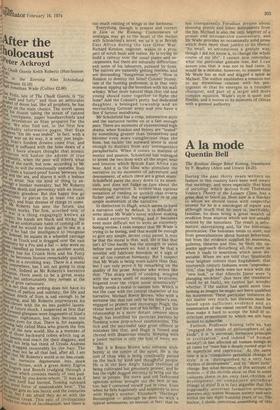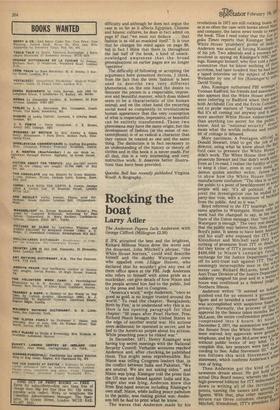A la mode
Quentin Bell
The Restless Image Rene Koenig, translated
by F. Bradley (Allen and Unwin £4.25).
During the past thirty years writers on fashion in this country have been well aware that sociology, and more especially that kind
of sociology which derives from Thorstein Veblen's Theory of the Leisure Class, has a
great deal to teach us. Here now is a teacher to whom we should listen with respectful interest for he is a sociologist of repute and although much that he says is, inevitably., familiar, he does bring a great wealth of erudition from sources which are not usually noticed by the historians. The result is infor mative, entertaining and, for the historian, provocative. The historian tends to start, not from generalisations about human behaviour, but from the evidence supplied by museums, galleries, libraries and film; he finds the op posite approach disturbing all the more so when it leads to assertions which seem disputable. When we are told that Spaniards wear brighter colours than Englishmen, that nineteenth century fashions were "unproductive," that high heels were not worn with the "new look," or that Albrecht DUrer wore "a plunging neckline" (but here the translator could be at fault), we cannot but wonder whether, if the author had spent more time looking at images he might not have qualified his statements. These particular instances do not matter very much, but theories must be based upon sufficient evidence and an examination of the visual record in this field does make it hard to accept the kind of intellectual propositions to which we are here invited to subscribe. Fashion, Professor Koenig tells us, has "engaged the minds of philosophers of all kinds"; it is "a universal, formative principle in civilisation" and indeed "of human society"; it has affected all human beings at all times for "man has a deeply rooted urge to be superficial and capricious." At the same time it is a "compulsive periodical change of style" it is "distinguished by a very fast rhythm of development", and by "short-term" change. But what becomes of this account of fashion — if the records show us that in some cultures there is no very fast rhythm of development, no compulsive periodical change of style? It is in fact arguable that this supposedly universal formative principle operates only within Western society and only within the last eight hundred years or so. The author, I think, perceives something of this difficulty and although he does not argue the case in so far as it affects Egyptian, Chinese and Islamic cultures, he does in fact admit on page 87 that "we must not deduce . . . that fashion is as old as mankind itself." It is true that he changes his mind again on page 89, but in fact I think that there is, throughout the last half of the book, a kind of unacknowledged awareness that the broad generalisations on earlier pages are no longer 'operative'.
The difficulty of following or accepting the arguments here presented derives, I think, from the fact that the term 'fashion' is here used to describe two very different phenomena, on the one hand the desire to decorate the person in a respectable, impressive and beautiful manner, which does indeed seem to be a characteristic of the human animal; and on the other hand the recurring social need so completely to revolutionise human appearance that the very conception of what is respectable, impressive, or beautiful can be entirely transformed. These two phenomena may have the same origin; but the development of fashion (in the sense of metamorphosis) is of so radical a character that they cannot be treated as one and the same thing. The distinction is in fact necessary to an understanding of the history or theory of clothes and in this book it is never made. For all that, this is a very interesting and. very instructive woek. It deserves better illustrations than have been provided.
Quentin Bell has recently published Virginia Woolf: A Biography.



































 Previous page
Previous page